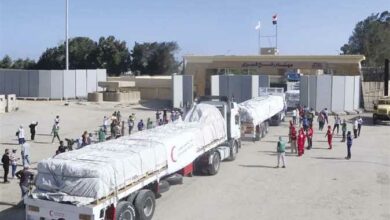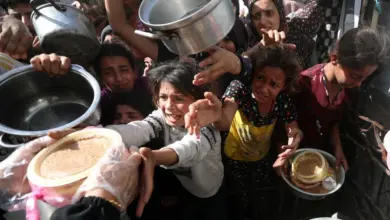If you’re up for trying something new, the backstreets of Cairo are host to a handful of restaurants from neighboring Sudan. A cross between African and Arabic cuisine, the Sudanese restaurants of Cairo are an excellent option for culinary explorers in search of a new dining experience.
Many of the dishes offered are stewed and puréed such that the ingredients are unrecognizable by sight. However, as hard as it was for us to decipher what we were eating, the friendly waiters at 'Khartoum,' a Sudanese restaurant near Opera square, were more than happy to describe the dishes to us.
The atmosphere is very Sudanese–you’ll rarely find foreigners among the patrons. On the wall of the restaurant hangs a picture of Sudanese President Omar el-Bashir, alongside one of John Garang, the former vice president and leader of Sudan's People's Liberation Army. The television often airs Sudanese political speeches or a football game featuring the Sudanese national team.
If you’re familiar with the Sudanese dialect of Arabic, you will notice that most of the guests are northerners, despite the fact that most of the dishes on offer–such as Baladi, Asida and Orasa–are common in both the country's north and south.
One of the plates we tried was Sudanese fasikh, which, unlike its Egyptian counterpart, is made of fresh fish that is usually imported from Sudan, according to our waiter. The Sudanese fasikh is ground into a pulp to which peanuts and tomato sauce are added. The texture and taste are smooth and delicious, and–unless your palate is more sensitive than ours–you won’t even know you are eating fish.
A common ingredient in many of these dishes seems to be ground okra. One okra dish we liked is called Na’emia, which, along with okra, is made with Rayeb milk, ground peanuts, tomatoes and spices.
There were also some tasty salads. Our favorite was Sawda, made with eggplant, parsley, tomatoes and onions in a peanut sauce. The locals scrape up the food with their hands, using bread or rice to absorb the sauces, but if you’re a foreigner, they’ll provide you with a spoon.
Two kinds of flat bread are served on the side: the baladi bread common in Egypt, and Kesra, a thin, squishy, sour bread. A third type of bread, Orasa, which is thick and fried, is usually served with a sauce poured over the top.
A cold glass of Tabaldi, a drink made from the fruit of the Baobab tree, was the perfect refreshing accompaniment to our meal, especially on a hot day. We finished off with a leisurely round of Sudanese coffee, or Gabana, poured from a tin carafe into Turkish coffee cups and spiced with ginger.
Some notable dishes
Sudanese Fasikh: Cooked “Kas” fish with ground peanuts and tomato sauce
Sawda: Eggplant salad
Om Rokika: Okra Soup
Gabana : Sudanese coffee brewed with ginger
Shia: Special meat dish made of lamb in small pieces
Om Fatfat: Intestine (Kersha)
Zaghny: Seasonings plus red sauce and eggs served with either chicken or beef (Ethiopian food)
Baladi: A main dish served with two different kinds of bread: Kesra (plain white, thin and squishy) and Korasa (fried thick-paste bread). Baladi itself comes as different dishes such as:
Na’emia: A mix of ground dry okra with Rayeb milk, ground peanuts and cooked tomato
Ta’lia: Dry okra with minced meat and tomato sauce, usually served with Orasa
Khadra: Molokhia
Mafrouka or Bamia: Green okra with spices
The Restaurants
Khartoum (Sudanese and oriental food): This is next to Opera Square, in an alley leading from Gomhorriya main street, across from Othman Katkhuda (known as Kekhia) Mosque. If you enter this tiny alley across from the mosque, you should notice a number of Sudanese gathering around the Gabana trails.
Sudani al-Shark: 2 Juhaina Street, Dokki, close to the Dokki Metro station.
Al-Sudan Restaurant: At the end of Downtown’s Kasr al-Nil Street in the direction of Al-Azhar; take the last left before the street ends (there is a jewelry shop on the corner).




